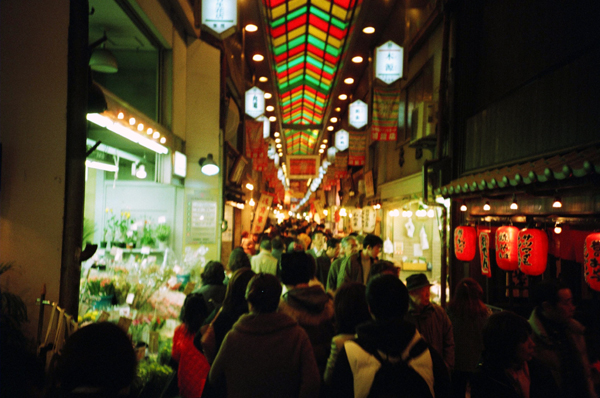11.23.2007 | Wii go to Sakurada

Last year Sugiyama-san arranged for the group to have a kaiseki lunch at Sakurada. No kidding, it may have been the best meal I've ever eaten. The food fresh, myriad, and inventive within the context of that rather standardized haute cuisine of the kaiseki meal. Sakurada is a small restaurant on a side alley near Shijo-dori. You know it by the small persimmon tree out front; when you enter you find yourself in a narrow, long house with an enclosed garden through a window toward the back. An older couple owns and runs the place; the man studied under one of Japan's famous ones and his wife and daughter choreograph from the scaffold of their kimono a seamless flow of courses from the kitchen to your table.
I contacted Sugiyama-san months in advance so that she could make the reservation. Sakurada is not that exclusive, but my ability to communicate in Japanese is poor and I didn't want to miss it or mis-order or not get the good food because they thought we wouldn't like it or know how to eat it.
When we arrived, they knew us by name and they had already decided what they were going to serve us. We sat and they brought out the oshibori and the tea, followed by the first course and all the rest in comfortable intervals. After our stay at Hiiragiya Bekkan, this kind of procession seemed almost old hat! But the food was as good as I remembered and it was so nice to share the spot with Andrew.
In the morning, we took the subway to south central Kyoto to find Nintendo headquarters. Before we left Seattle, I asked someone I know who used to work at the headquarters if it is possible to visit. But she said that no visitors are allowed because the buildings is where all of the R&D occurs. So, like everyone else who has made the pilgrimage, we found the building and walked the perimeter, taking pictures of the big white cube. This, plus the shinkansen, the electronics market, the knife store, and high-end tempura for Andrew.

After lunch we walked north to Nishiki market to revisit some shops and buy gifts. We also visited the old broom shop and a sembei shop that had been in business for years. I wanted to visit a bamboo weaver's shop, so we found the one I'd read about and browsed the baskets there. Of course, the ones I liked were very expensive and I liked none well enough to justify the price. It's a dying art, that business. Traditionally, the bamboo is aged before it can be woven, but these days so many cheaply crafted alternatives are available that it's difficult for the traditional artisans to stay in business. Their longstanding customers include the old gentry, but how long before their younger generations abandon the tradition of buying from masters? Last year we learned from the teachers at Urasenke that chasen are no longer hand-crafted in Japan. They said none at all—all come from China now. You can't brew matcha without chasen, so the news was surprising and disheartening to me.
A cold night. We returned to Teramachi-dori and walked north toward Oike-dori. This time, because we leave day after tomorrow, I stopped at the sweet shop on the corner of Teramachi and Oike to buy a bunch of sweets. It's a modest shop, but the sweets have a lot of flare. I can't wait to try them.
By the time we returned to the ryokan we were quite chilled and tired. Rather than going all the way downtown for dinner, we located a grocery store and bought ramen. Doing this was amazingly cheap compared to some of the meals we've been having. We returned to the room, cranked up the heater, put on our yukata, and had a comforting meal of ramen and pocky. Afterward we discovered that it was difficult to dispose of the leftover broth and noodles at the ryokan. Above the sinks, signs say not to pour down any food and you can't dispose of the food in the trash. We decided that the culture shapes behavior by making it very difficult to do things. Therefore, necessities sometimes are driven underground, and that's why, long after midnight, I went into the one of the bathrooms, removed the strainer from the sink there, and very carefully strained the broth from the remaining noodle and vegetable bits so that there was no evidence of anything other than water having gone down the drain. I put the rest of the container, noodle bits and all, into the trash.